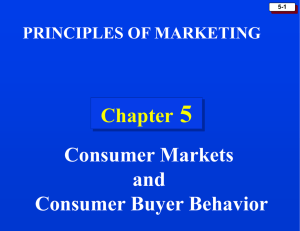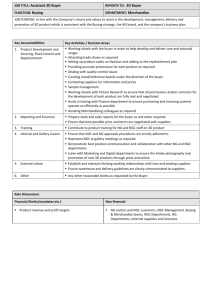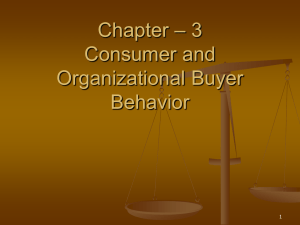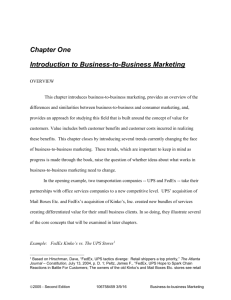The 7 Key Differences Between business-to
advertisement
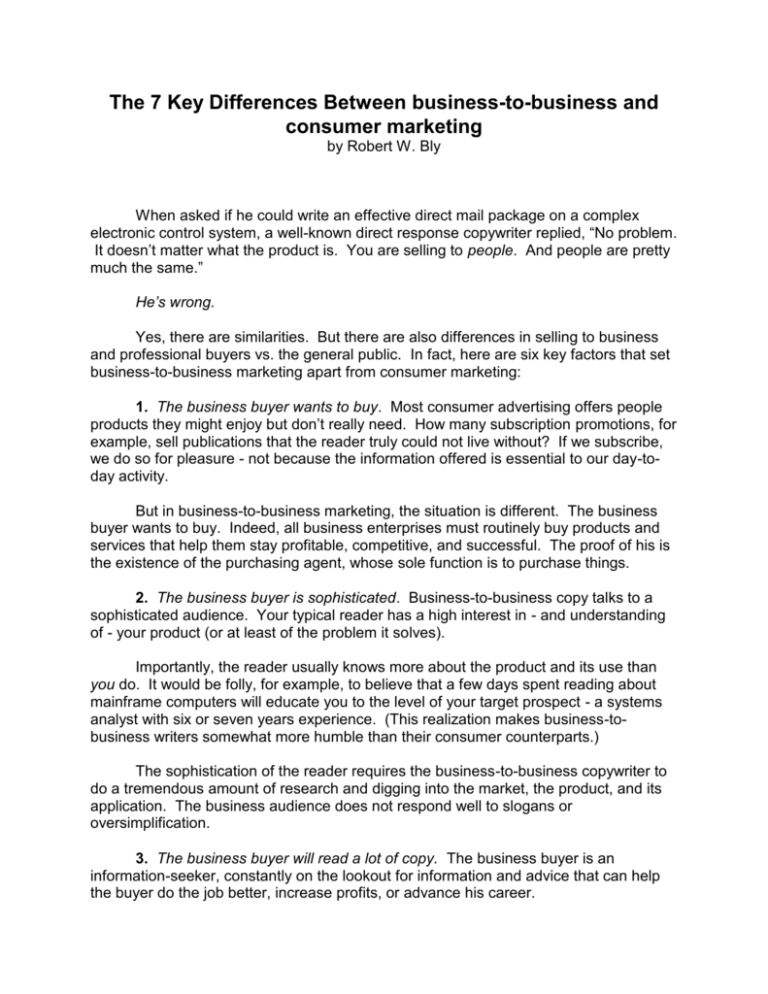
The 7 Key Differences Between business-to-business and consumer marketing by Robert W. Bly When asked if he could write an effective direct mail package on a complex electronic control system, a well-known direct response copywriter replied, “No problem. It doesn’t matter what the product is. You are selling to people. And people are pretty much the same.” He’s wrong. Yes, there are similarities. But there are also differences in selling to business and professional buyers vs. the general public. In fact, here are six key factors that set business-to-business marketing apart from consumer marketing: 1. The business buyer wants to buy. Most consumer advertising offers people products they might enjoy but don’t really need. How many subscription promotions, for example, sell publications that the reader truly could not live without? If we subscribe, we do so for pleasure - not because the information offered is essential to our day-today activity. But in business-to-business marketing, the situation is different. The business buyer wants to buy. Indeed, all business enterprises must routinely buy products and services that help them stay profitable, competitive, and successful. The proof of his is the existence of the purchasing agent, whose sole function is to purchase things. 2. The business buyer is sophisticated. Business-to-business copy talks to a sophisticated audience. Your typical reader has a high interest in - and understanding of - your product (or at least of the problem it solves). Importantly, the reader usually knows more about the product and its use than you do. It would be folly, for example, to believe that a few days spent reading about mainframe computers will educate you to the level of your target prospect - a systems analyst with six or seven years experience. (This realization makes business-tobusiness writers somewhat more humble than their consumer counterparts.) The sophistication of the reader requires the business-to-business copywriter to do a tremendous amount of research and digging into the market, the product, and its application. The business audience does not respond well to slogans or oversimplification. 3. The business buyer will read a lot of copy. The business buyer is an information-seeker, constantly on the lookout for information and advice that can help the buyer do the job better, increase profits, or advance his career. “Our prospects are turned off by colorful, advertising-type sales brochures,” says the marketing manager of a company selling complex ‘systems’ software products to large IBM data centers. “They are hungry for information and respond better to letters and bulletins that explain, in fairly technical terms, what our product is and how it solves a particular data-center problem.” Don’t be afraid to write long copy in mailers, ads, and fulfillment brochures. Prospects will read your message - if it is interesting, important, and relevant to their needs. And don’t hesitate to use informational pieces as response hooks for ads and mailers. The offer of a free booklet, report, or technical guide can still pull well - despite the glut of reading matter clogging the prospect’s in-basket. 4. A multistep buying process. In consumer direct response, copywriters’ fees are geared toward producing the “package” - an elaborate mailing that does the bulk of the selling job for a publication, insurance policy, or other mail order product. But in business-to-business direct marketing, the concept of package or control is virtually non-existent. Why? Because the purchase of most business products is a multistep buying process. A vice president of manufacturing doesn’t clip a coupon and order a $35,000 machine by mail. First he asks for a brochure. Then a sales meeting. Then a demonstration. Then a 30-day trial. Then a proposal or contract. Thus, it is not a single piece of copy that wins the contract award. Rather, it takes a series of letters, brochures, presentations, ads, and mailers - combined with the efforts of salespeople - to turn a cold lead into a paying customer. 5. Multiple buying influences. You don’t usually consult with a team of experts when you want to buy a fast-food hamburger, a soda, bottle of shampoo, or a pair of shoes, do you? In most consumer selling situations, the purchase decision is made by an individual. But a business purchase is usually a team effort, with many players involved. For this reason, a business purchase is rarely an “impulse” buy. Many people influence the decision - from the purchasing agent and company president, to technical professionals and end-users. Each of these audiences has different concerns and criteria by which they judge you. To be successful, your copy must address the needs of all parties involved with the decision. In many cases, this requires separate mailings to many different people within an organization. 6. Business products are more complex. Most business products - and their applications - are more complex than consumer products. (For example, clients I now serve include a commercial bank, a manufacturer of elevator control systems, a data processing training firm, a database marketing company, a mailing list broker, a general contractor, and a semiconductor manufacturer.) Business-to-business copy cannot be superficial. Clarity is essential. You cannot sell by “fooling” the prospect or hiding the identity of your product. Half the battle is explaining, quickly and simply, what your product is, what it does, and why the reader should be interested in it. “In high-tech direct mail, the key is to educate the prospect,” say Mark Toner, who manages the advertising program for Amano, a manufacturer of computerized time-clock systems. “With a product like ours, most customers don’t even know of its existence.” In short, in business-to-business marketing, the rules are different. In the months to come, we’ll explore ways to increase response and profits in this exciting and challenging marketplace. Business buyers are looking for personal benefits by Robert W. Bly In a column titled “The 7 Key Differences Between Business-To-Business And Consumer Marketing,” I described the six key factors that set business-to-business marketing apart from consumer marketing. They are: The business buyer wants to buy. The business buyer is sophisticated. The business buyer is an information seeker who will read a lot of copy. Business-to-business marketing involves a multistep buying process. The buying decision is frequently made by a committee and not by an individual. Business products are generally more complex than consumer products. Recently, I have formulated a seventh principle which I would like to add to the list The business buyer buys for his company’s benefit - and his own. There are two parts to this principle. Let’s take them one at a time. The Business Buyer Buys For His Company’s Benefit The business buyer must acquire products and services that benefit his company. This means the product or service saves the company time or money, makes money, improves productivity, increases efficiency or solves problems. Let’s say, for example, that you sell a telecommunications network and your primary advantage over the competition is that your system reduces monthly operating expenses by 50 percent. If a prospect is spending $40,000 a month for your competitor’s network, you can replace it and provide his company with the same level of service for only $20,000 a month. The company benefits because it saves $240,000 a year in communications costs - more than $1 million in a five-year period. Yet, despite this tremendous benefit, you find that prospects are not buying. They seem interested, and you get a lot of inquiries. But few sales are closed. Why? Because in addition to buying for his company’s benefit, the prospect also buys for himself. The Business Buyer Buys For His Own Benefit The second part of principle #7 is that, while the buyer is looking to do right by his company, he has an equal (if not greater) concern for his own well-being and selfish interests. Although the idea of saving $240,000 a year with your telecommunications system is appealing to your prospect, his thought process is as follows: “Right now I have an AT&T system. Your system sounds good but I don’t know you or your company. If I switch and something goes wrong, I will be blamed. I may even get fired. My boss will say, ‘You shouldn’t have gambled on an unproven product from an unknown vendor - why didn’t you stick with good ole reliable AT&T?’ He will say this even though he approved my decision. So to be safe, I will stick with my current system...even though it costs my company an extra $240,000 a year. After all, I’d rather see them spend an extra $240,000 a year than me lose my $60,000-a-year-job!” This play-it-safe mentality is only natural, and it affects buying decisions daily in corporations throughout the country. Data processing professionals are fond of saying, “Nobody ever got fired for buying IBM.” Buying IBM ensures the prospect that no one can criticize his decision, even if brand X is the better choice from a business and technical point of view. A corporate pension fund manager, writing in Money magazine, noted that no money manager ever got fired for losing money invested in a blue-chip stock. A different example, but the principle remains the same. The Business Buyer Is For Himself Concern for making the safe, acceptable decision is a primary motivation of business buyers, but it is not the only reason why business buyers choose products, services and suppliers that are not necessarily the best business solution to their company’s problem. Avoiding stress or hardship is a big concern among prospects. For example, a consultant might offer a new system for increasing productivity, but it means more paperwork for the shipping department...and especially for the head of the shipping department. If he has anything to say about it, and thinks no one will criticize him for it, the head of shipping will, in this case, work to sway the committee against engaging the consultant or using his system...even though the current procedures are not efficient. The department head, already overworked, wants to avoid something he perceives as a hassle and a headache, despite its contribution to the greater good of the organization. Fear of the unknown is also a powerful motivator. A middle manager, for example, might vote against acquiring desktop publishing and putting a terminal on every manager’s desk because he himself has computer phobia. Even though he recognizes the benefit such technology can bring to his department, he wants to avoid the pain of learning something he perceives to be difficult and frightening. Again, personal benefit outweighs corporate benefit in this situation. Fear of loss is another powerful motivator. An advertising manager in a company that has handled its advertising in-house for the past decade may resist his president’s suggestion that they retain an outside advertising agency to handle the company’s rapidly expanding marketing campaign. Even if he respects the ad agency and believes they will do a good job, the ad manager may campaign against them, fearing that bringing in outside experts will diminish his own status within the company. In these and many other instances, the business buyer is for himself first; and his company, second. To be successful, your copy must not only promise the benefits the prospect desires for his company; it should also speak to the prospect’s personal agenda, as well.

